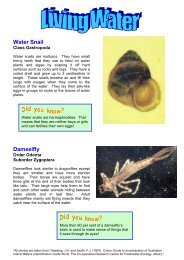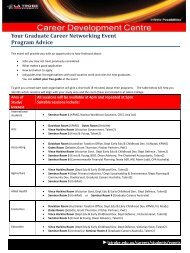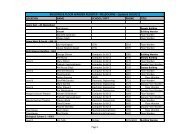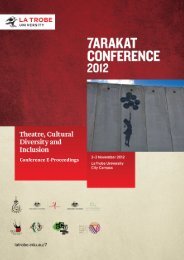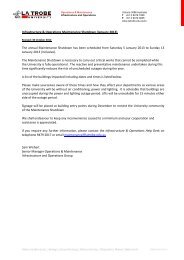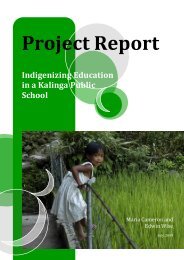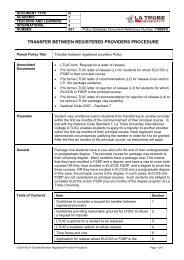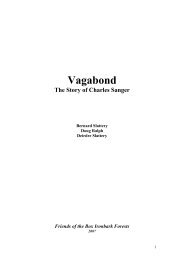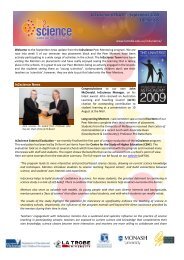Sep 2004 PDF - La Trobe University
Sep 2004 PDF - La Trobe University
Sep 2004 PDF - La Trobe University
You also want an ePaper? Increase the reach of your titles
YUMPU automatically turns print PDFs into web optimized ePapers that Google loves.
LA TROBE UNIVERSITY<br />
SEPTEMBER <strong>2004</strong><br />
FIGHTING HIV/AIDS<br />
in Papua New Guinea<br />
FOUND:<br />
The real Leopold Bloom<br />
MUSCLES:<br />
They’re smarter<br />
than we thought
LA TROBE UNIVERSITY<br />
Bulletin<br />
IN THIS ISSUE<br />
Space eye across the Tasman 3<br />
Pharmaceutical drug scheme for Croatia 4<br />
Fighting HIV / AIDS in Papua New Guinea 5<br />
Helping school students get ‘In2Science’ 6<br />
Research in Action<br />
Better internet services for the Bush 7<br />
Muscles: They’re smarter than we thought 8<br />
Found: The real Leopold Bloom 9<br />
Searching for biological markers<br />
of autism 10<br />
Migrant English:<br />
Understanding intelligibility 11<br />
Behavioural change –<br />
from water use to family violence 12<br />
Masters course boosts<br />
Global Business <strong>La</strong>w 13<br />
People: Professorial appointments 14 & 15<br />
New Deputy Vice-Chancellor (Research) 15<br />
Good news in Vietnam 16<br />
2<br />
Cover: Scientists at <strong>La</strong> <strong>Trobe</strong><br />
<strong>University</strong> and at the <strong>University</strong> of<br />
Aarhus in Denmark, have discovered<br />
the mechanism by<br />
which acidity helps prevent muscle<br />
fatigue – see story page 8<br />
The <strong>La</strong> <strong>Trobe</strong> Bulletin is published ten times a year by the<br />
Public Affairs Office, <strong>La</strong> <strong>Trobe</strong> <strong>University</strong>.<br />
Articles may be reproduced with acknowledgement.<br />
Photographs can be supplied.<br />
Enquiries and submissions to the editor, Ernest Raetz,<br />
<strong>La</strong> <strong>Trobe</strong> <strong>University</strong>, Victoria. 3086 Australia<br />
Tel (03) 9479 2315, Fax (03) 9479 1387<br />
Email: bulletin@latrobe.edu.au<br />
Design: Campus Graphics, 57072<br />
<strong>La</strong> <strong>Trobe</strong> <strong>University</strong>.<br />
Photography: PDI COMET, <strong>La</strong> <strong>Trobe</strong> <strong>University</strong>.<br />
Printed by Print Management Group.<br />
Website: www.latrobe.edu.au/bulletin<br />
NEWS<br />
Peacemaking starts<br />
IN THE PLAYGROUND<br />
By October 2006, a thousand young<br />
peacemakers – each one trained in conflict<br />
resolution skills – will be enhancing<br />
relationships between children, teachers and<br />
parents in five Victorian primary schools.<br />
And hopefully, their peacemaking skills<br />
will be used throughout their lives to make<br />
Australian society more peaceful and tolerant.<br />
This is the aim of a two-year project – based<br />
on techniques developed at <strong>La</strong> <strong>Trobe</strong><br />
<strong>University</strong> – to be launched this October.<br />
Called ‘Enhancing Relationships in School<br />
Communities’, the project has been<br />
developed, and will be supervised, by a fiveperson<br />
team. Much of it is based on a conflict<br />
resolution model developed by <strong>La</strong> <strong>Trobe</strong> staff<br />
in the School of Psychological Science,<br />
including Dr Eleanor Wertheim.<br />
Dr Wertheim is working with Ms Elizabeth<br />
Freeman, Ms Pat Marshall and Dr Ann Sanson<br />
of the <strong>University</strong> of Melbourne and Ms Margot<br />
Trinder of Psychologists for the Promotion of<br />
World Peace, an interest group of the Australian<br />
Psychological Society, and the Brencorp<br />
Foundation. The Foundation has supported the<br />
project with $63,000 for two years.<br />
The project assists primary school teachers to<br />
help students learn to deal more effectively<br />
with issues ranging from everyday friendship<br />
conflicts, peer pressure, conflicts between<br />
groups of students, bullying and aggression<br />
and conflict with teachers and parents.<br />
Dr Wertheim says conflict and differences<br />
between people are part of life. They make for<br />
LA TROBE UNIVERSITY BULLETIN<br />
an interesting and changing world and provide<br />
opportunities for learning and growth.<br />
However, if differences between people –<br />
particularly between children – are not<br />
accepted or are handled badly, there can be<br />
negative consequences.<br />
For children, poorly managed conflict can<br />
result in bullying and aggression, increased<br />
classroom disruption, heightened anxiety,<br />
early school leaving, intolerance and racism.<br />
Under the program, teachers from schools in<br />
multi-cultural areas will be taught conflict<br />
resolution skills and then supported over two<br />
years. The teachers will then pass on their<br />
skills to pupils so that by the end of 2006,<br />
1,000 students will have effective conflict<br />
resolution skills.<br />
The program includes active listening,<br />
perspective taking, challenging assumptions<br />
and stereotype and consensus building.<br />
Dr Wertheim said the conflict resolution model<br />
used is based on the Harvard <strong>University</strong><br />
Negotiation Project. It has been developed for<br />
Australian conditions by Dr Wertheim and Dr<br />
Anthony Love, with colleagues Dr Lyn<br />
Littlefield and Dr Connie Peck.<br />
Dr Wertheim is also helping develop<br />
posters for schools and other places where<br />
children gather. ‘Our aim,’ she says, ‘is for<br />
children to become empowered and skilled in<br />
conflict resolution so that eventually our<br />
whole society is proficient at resolving<br />
conflict constructively.’ �
The New Zealand component of the<br />
Tasman International Geospace<br />
Environment Radar (TIGER) will<br />
become operational in November. This<br />
follows the completion at <strong>La</strong> <strong>Trobe</strong><br />
<strong>University</strong> of a radar to be installed near<br />
Invercargill, NZ, in October.<br />
A ceremony was held at <strong>La</strong> <strong>Trobe</strong>’s main<br />
Melbourne campus at Bundoora recently to<br />
mark the completion of the radar’s<br />
construction.<br />
Headed by <strong>La</strong> <strong>Trobe</strong>’s Physics<br />
Department, TIGER is an important<br />
Australian contribution to space physics,<br />
facilitating research and providing services in<br />
space physics and space weather. <strong>La</strong> <strong>Trobe</strong><br />
operates TIGER on behalf of a consortium of<br />
universities, government departments and<br />
commercial firms.<br />
TIGER’s first component to go into<br />
operation was a similar ionospheric radar<br />
with a 300 metre long antenna, installed on<br />
Bruny Island, Tasmania in 1999. It probes a<br />
fifty-two degree sector in azimuth with a<br />
range from 200 km south of Tasmania to the<br />
Antarctic coast 3,000 km away.<br />
The New Zealand component is a similar<br />
but improved ‘stereo’ version of the Bruny<br />
Island radar. The radar electronics has just<br />
been completed at <strong>La</strong> <strong>Trobe</strong> and the antenna<br />
component is already installed on a farming<br />
property 15 km from Invercargill.<br />
When the system becomes fully<br />
operational in November, TIGER’s<br />
capability will be greatly enhanced. Each<br />
radar will emit beams that will cross, giving<br />
different line of sight velocities that can be<br />
combined to provide scientists with accurate<br />
‘vector’ velocities of motions in the highly<br />
disturbed auroral ionosphere.<br />
TIGER is part of an international network<br />
of similar radars called SuperDARN (Super<br />
Dual Auroral Radar Network) operated by<br />
ten nations to provide simultaneous coverage<br />
of both southern and northern polar regions.<br />
The head of <strong>La</strong> <strong>Trobe</strong>’s Physics<br />
Department, Professor Peter Dyson, and<br />
Dr John Devlin, an Associate Professor in<br />
the Department of Electronic Engineering,<br />
developed TIGER. Professor Dyson is<br />
TIGER’s principal investigator and Dr<br />
Devlin its scientist-engineer and is<br />
responsible for the development of the<br />
radar system.<br />
The NZ radar has been named ‘Unwin’<br />
after New Zealander Dr Bob Unwin, who<br />
was a pioneer in ionospheric studies. He set<br />
up an auroral radar in Southland in 1957 and<br />
later explored the possibility of having a<br />
second radar in Tasmania.<br />
TIGER will explore the impact of solar<br />
disturbances on Earth by monitoring the<br />
location of aurora and related phenomena<br />
occurring in the ionosphere – 100 to 300 km<br />
above the earth.<br />
It explores an area half the size of Australia<br />
by directing HF radio signals via the<br />
ionosphere towards Antarctica and detecting<br />
weak echoes from structures in the<br />
ionosphere. These echoes are used to form<br />
images of the ionospheric structures and<br />
measure their speed and direction of motion.<br />
It also detects echoes from meteors<br />
which are used to calculate wind speeds at<br />
heights of around 100km. It can also detect<br />
signals from the sea and methods of<br />
deducing the sea-state from these signals are<br />
being developed.<br />
NEWS<br />
Measuring the impact of solar disturbances and detecting echoes from meteors...<br />
Space eye reaches across the<br />
Tasman<br />
Professor Dyson at <strong>La</strong> <strong>Trobe</strong> and, inset, the radar under construction in New Zealand.<br />
Results from the full operation of TIGER<br />
will include greater knowledge of space<br />
physics and space weather processes which<br />
is required to improve management of radio<br />
communications and navigation systems<br />
such as GPS. It also has relevance to satellite<br />
operations and magnetic surveying for<br />
minerals and electricity supplies.<br />
When the sun’s corona ejects huge<br />
amounts of matter that reach the Earth, there<br />
are rapid changes in wind speed and<br />
temperature in the ionosphere as well as the<br />
magnetosphere – that region where the<br />
earth’s magnetic field interacts with the<br />
solar wind.<br />
Auroras are caused by electrons striking<br />
molecules and atoms after entering the<br />
earth’s atmosphere near the poles. The<br />
location of aurora can move 500 km in less<br />
than a minute during magnetic storms and<br />
can disrupt communication and navigation<br />
systems. TIGER monitors such storms and<br />
can provide real-time data on space weather<br />
storms.<br />
TIGER uses HF radio waves in the 8 - 20<br />
MHz range. It consumes only 2 kW of<br />
power, the same as some electric kettles, and<br />
transmits an average power of 200 W – the<br />
same as two bright light globes. �<br />
SEPTEMBER <strong>2004</strong> 3
4<br />
GLOBAL HEALTH<br />
BETTER PHARMACEUTICAL DRUG SCHEME<br />
FOR CROATIA<br />
Dr Harvey, left, with Dr Karolina Kalanj, Croatian Project Manager.<br />
<strong>La</strong> <strong>Trobe</strong> senior lecturer in Public Health, Dr Ken Harvey –<br />
a specialist in the design of public policy to optimise the<br />
use of antibiotics and other medicinal drugs – has played<br />
a major role in introducing a cost efficient pharmaceutical<br />
drug scheme in Croatia.<br />
Dr Harvey was a member of an Australian Health Insurance<br />
Commission (HIC) team which won a World Bank contract to help<br />
the Croatian Ministry of Health and the Croatian Institute for Health<br />
Insurance reform the country’s pharmaceutical sector. This<br />
followed Croatian government concern about the relatively high<br />
cost of drugs and inappropriate prescribing habits by physicians.<br />
Through research, commissioned policy papers and his inaugural<br />
membership of the Commonwealth Pharmaceutical Health and<br />
Rational use of Medicines (PHARM) Committee, Dr Harvey has<br />
helped formulate Australian medicinal drug policy.<br />
He has also worked in 12 Asian countries under the auspices of<br />
the World Health Organisation, AusAID and the Regional Office for<br />
Asia and the Pacific of Consumers International.<br />
Dr Harvey said Australian medicinal drug policy was held in<br />
high regard internationally. In particular, he said Australia’s 55-<br />
LA TROBE UNIVERSITY BULLETIN<br />
year-old Pharmaceutical Benefits Scheme was world renowned<br />
for subsidising most of the cost of around 600 drugs for<br />
Australian consumers and for using stringent pharmacoeconomic<br />
analysis to negotiate drug prices two to three times<br />
lower that that paid in the USA.<br />
‘In addition, our “Quality Use of Medicines” policy encourages<br />
rational prescribing and use by providing independent drug and<br />
therapeutic information, analysis and feedback of drug utilisation<br />
data, and educational programs run by the National Prescribing<br />
Service,’ he said.<br />
Dr Harvey spent three months in Croatia in 2003 and early <strong>2004</strong><br />
helping devise a national policy which encouraged the use of<br />
pharmaco-economic principles in the selection and purchase of the<br />
Croatian national drug list.<br />
The team with which he was working recommended new<br />
drug funding and reimbursement options, reviewed drug use<br />
data and developed prescribing guidelines and feedback<br />
systems to encourage physicians to practice in accord with the<br />
national guidelines.<br />
In addition, it developed and conducted education programs in<br />
pharmaco-economics for personnel involved in drug selection and<br />
pricing, courses in rational prescribing for clinical pharmacologists<br />
and physicians, and reviewed plans for the establishment of a<br />
Croatian National Drug Agency. This culminated in an information<br />
campaign for the general public.<br />
Specifically, Dr Harvey's role involved adapting and translating<br />
Australian therapeutic guidelines to suit local conditions, using<br />
insurance data to monitor doctors prescribing practice and devising<br />
performance indicators, linked to financial incentives, to encourage<br />
physicians to follow the guidelines.<br />
The Croatian Institute for Health Insurance accepted his<br />
recommendations, resulting in performance indicators and financial<br />
incentives being written into new contracts for Croatian general<br />
practitioners this year.<br />
Dr Harvey also worked with a primary health care information<br />
technology project which aims to incorporate the guidelines devised<br />
into prescribing software being piloted in Croatia. He also played a<br />
leading role in the educational program for clinical pharmacologists<br />
and physicians.<br />
Many countries, he said, face similar problems to those<br />
experienced by Croatia. Neighbouring counties such as Bosnia,<br />
Montenegro and Serbia are very interested in the Croatian<br />
pharmaceutical project. The Australian HIC has won a similar<br />
contract in Jordan and Dr Harvey is soon to return to Jordan as part<br />
of the team. �
Fighting HIV/AIDS in<br />
<strong>La</strong> <strong>Trobe</strong> <strong>University</strong>’s National Centre<br />
for Public Health <strong>La</strong>w is making a<br />
significant contribution to combating<br />
the HIV/AIDS epidemic in Papua New<br />
Guinea. The Centre is also involved in<br />
developing legislative options to help deliver<br />
a range of other health services in PNG.<br />
Inaugurated in November 2002, the<br />
National Centre for Public Health <strong>La</strong>w<br />
(NCPHL) has already completed one<br />
assignment on HIV/AIDS for the PNG<br />
Government through AusAID, the<br />
Australian Government's overseas aid<br />
program, and is engaged in another to<br />
improve the delivery of all health services.<br />
A legal intern at the Centre, Ms Karen<br />
Fletcher, prepared a handbook on new<br />
HIV/AIDS laws with the support and<br />
assistance of Centre Director, Ms Genevieve<br />
Howse, who also developed and<br />
implemented a training program for those<br />
using the handbook.<br />
As well as preparing the handbook which<br />
will be published later this year, Ms Howse<br />
and Ms Fletcher also conducted training<br />
sessions for people who will use it. Groups<br />
involved included the staff of the<br />
Ombudsman’s Office, members of the<br />
Royal PNG Constabulary, defence force<br />
personnel and teachers.<br />
Ms Fletcher spent three months in PNG and<br />
Ms Howse made two visits of one week each.<br />
Their involvement in PNG follows the<br />
passage of the HIV/AIDS Management and<br />
Prevention Act through the PNG parliament in<br />
August, 2003. The Act is designed to combat<br />
the epidemic which some commentators say<br />
will be as significant a problem in PNG in 10<br />
years as it is in Africa today.<br />
‘It is a very progressive piece of<br />
legislation,’ Ms Howse said. ‘It forbids<br />
discrimination against, and vilification of,<br />
people with HIV/AIDS and is designed to<br />
protect the rights of both those who have<br />
the infection and those who don’t.’<br />
Nevertheless, it is still not socially or<br />
culturally acceptable to talk openly about<br />
HIV/AIDS and its transmission. Because of<br />
this, it is not possible to gauge accurately<br />
how many people have the infection.<br />
Despite the fact that the Act is now law,<br />
Ms Howse and Ms Fletcher witnessed an<br />
incident which demonstrated the need for<br />
the Act and for promoting it among officials<br />
and others.<br />
Police raided a licensed club in Port<br />
Moresby, arrested 80 people and humiliated<br />
them during a one hour march to a police<br />
station, making them inflate condoms as<br />
they passed through crowds. <strong>La</strong>ter all men<br />
were released, but six girls under the age of<br />
18 were charged with prostitution because<br />
they had condoms in their possession. The<br />
charges were later withdrawn, following<br />
GLOBAL HEALTH<br />
PAPUA NEW GUINEA<br />
legal advocacy for the women involved,<br />
sponsored by the National AIDS Council.<br />
Ms Howse said she was concerned that<br />
religious and social attitudes could place<br />
serious impediments on the operation of the<br />
new Act.<br />
‘A sex worker going to a clinic for a<br />
HIV/AIDS test can be so humiliated by staff<br />
with personal prejudices that she often will<br />
not return for her results. The new Act<br />
makes such discrimination illegal – but it is<br />
necessary to change attitudes as well as<br />
laws,’ she said. �<br />
SEPTEMBER <strong>2004</strong> 5
6<br />
SCIENCE EDUCATION<br />
UNIVERSITY MENTORS ARE HELPING<br />
SCHOOL STUDENTS<br />
GET ‘In2Science’<br />
Aprogram to encourage<br />
more Victorian secondary<br />
school students to ‘get<br />
into science’ was recently<br />
launched by <strong>La</strong> <strong>Trobe</strong><br />
<strong>University</strong> and the<br />
<strong>University</strong> of Melbourne in metropolitan<br />
Melbourne and regional Victoria.<br />
A new joint venture in Victoria, the<br />
program – called ‘In2Science’ – is run by<br />
the Science Faculties at the two<br />
universities. It has been funded by the<br />
William Buckland Foundation.<br />
‘In2Science’ places selected science<br />
students from <strong>La</strong> <strong>Trobe</strong> and Melbourne in<br />
secondary schools for up to three hours a<br />
week in fourteen-week blocks.<br />
The university students then act as<br />
mentors and role models for school<br />
students – especially those in the middle<br />
years of their secondary education, years<br />
7-10. They also serve as an additional<br />
resource for teachers to enhance existing<br />
science programs.<br />
<strong>La</strong> <strong>Trobe</strong> <strong>University</strong> Dean of the Faculty<br />
of Science, Technology and Engineering,<br />
Professor David Finlay – who is also<br />
President of the Australian Council of<br />
Science Deans – said initially nine<br />
<strong>La</strong> <strong>Trobe</strong> students will take part in<br />
the program.<br />
‘The aim is to promote enthusiasm for<br />
science among secondary students,<br />
especially in key subjects like Chemistry,<br />
Mathematics and Physics, and to help<br />
students make choices about future higher<br />
education options which can lead to<br />
rewarding and interesting career choices.’<br />
Professor Finlay said the scheme also<br />
benefits university students by enhancing<br />
their skills in science communication.<br />
Professor John McKenzie, Dean of<br />
Science at the <strong>University</strong> of Melbourne,<br />
said: ‘In2Science will help broaden the<br />
experiences and opportunities for<br />
LA TROBE UNIVERSITY BULLETIN<br />
students in schools and universities to<br />
share their passion and cultivate their<br />
curiosity in science.’<br />
‘We are most grateful for the support<br />
from the William Buckland Foundation,<br />
which has enabled university students to<br />
assist the development of science<br />
education in schools.’<br />
<strong>La</strong> <strong>Trobe</strong> <strong>University</strong> Peer Mentoring Coordinator,<br />
John McDonald, said the new<br />
Victorian program was based on a<br />
successful scheme called STAR which has<br />
been run through Western Australia’s<br />
Murdoch <strong>University</strong> for the past 11 years.<br />
Currently there are more than 300<br />
Australian university students involved in<br />
such programs.<br />
‘Schools have been very positive,’ Mr<br />
McDonald said. ‘They see its potential<br />
value to both staff and students and, as the<br />
program grows, we hope to involve more<br />
schools and mentors each year.’<br />
Nine metropolitan secondary schools,<br />
Eltham High School, St Helena Secondary<br />
College, Mill Park Secondary College,<br />
East Doncaster Secondary College,<br />
Macleod College, Pascoe Vale Girls’<br />
Secondary College, Northcote High<br />
School, Princes Hill Secondary College<br />
and Melbourne Girls’ College, and one<br />
regional school, Mitchell High School in<br />
Wodonga, are participating in the<br />
inaugural year of the program. �<br />
The scheme’s launch at Northcote High School with ‘In2Science’ chair, former Federal Government<br />
Science Minister, Dr Barry Jones, and <strong>La</strong> <strong>Trobe</strong>’s Professor Finlay, both far right.<br />
Further information from John<br />
McDonald, telephone: 9479 2523 or<br />
email: j.mcdonald@latrobe.edu.au
<strong>La</strong> <strong>Trobe</strong> <strong>University</strong> is playing a major role<br />
in research designed to bring better<br />
internet services to remote rural areas.<br />
Principal investigator, <strong>La</strong> <strong>Trobe</strong>’s Dr<br />
Ben Soh, leads a team that recently won an<br />
ARC Linkage Grant to develop a new<br />
transport layer protocol to provide secure<br />
broadband internet connection via satellite<br />
to rural regions.<br />
The team includes input from Telstra<br />
Country Wide, URSYS Pty Ltd (Sydney)<br />
and Associate Professor Dr Jean<br />
Armstrong, a former <strong>La</strong> <strong>Trobe</strong> researcher,<br />
now at Monash <strong>University</strong>. Their $161,000<br />
grant also funds PhD student Mr Joel Sing<br />
from <strong>La</strong> <strong>Trobe</strong>, Bendigo’s Information and<br />
Communication Technology Centre. In<br />
addition, Telstra is contributing access to<br />
its satellite technology.<br />
Dr Soh, senior lecturer in <strong>La</strong> <strong>Trobe</strong>’s<br />
Department of Computer Science and<br />
Computer Engineering, said satellite links<br />
were critical to connecting broadband to<br />
remote areas.<br />
‘Effective use of the internet over<br />
satellite links is essential if Businessto-Business<br />
and Business-to-<br />
Consumer E-commerce is to<br />
develop in these areas. In many<br />
application networks –<br />
particularly virtual private<br />
networks (VPN) – secure<br />
transmission is important to<br />
avoid fraud and maintain<br />
privacy. Satellite links<br />
introduce a long delay<br />
(latency) in the transmission<br />
path and existing secure internet<br />
protocols do not handle this well.’<br />
Dr Soh said transmission control<br />
protocol (TCP) over satellite VPN was<br />
RESEARCH IN ACTION<br />
Better internet services for<br />
THE BUSH<br />
possibly the hottest research topic in the<br />
rural economy today. Combined, these two<br />
technologies had the potential to provide the<br />
best and most cost-effective ‘information<br />
superhighways’ in remote areas.<br />
TCP was part of the most widely used<br />
network protocol. ‘We expect the total<br />
market for satellite services provided by<br />
these technologies and the accompanied<br />
activities to be worth billions of dollars.’<br />
Dr Soh’s team aims to develop new TCP<br />
security techniques for broadband internet<br />
connections via satellite to a VPN.<br />
Internet messages, he explained, are<br />
broken into ‘packets’ at the TCP layer for<br />
routing via the Internet Protocol layer to<br />
the destination address. There, the packets<br />
are reassembled at the TCP layer to<br />
recover the original messages. However,<br />
numerous problems remain.<br />
A major one is the relatively<br />
high latency when data is<br />
transmitted. The length<br />
of the latency<br />
depends<br />
on the satellite’s orbit. Geosynchronousearth-orbit<br />
satellites have latency of about<br />
560 milliseconds over the earth-satelliteearth<br />
link, while low-earth-orbit satellites<br />
have 10 to 20 milliseconds one-way delay,<br />
depending on the satellite’s location in the<br />
sky and other factors. These delays make<br />
real time systems impossible.<br />
Another TCP issue being investigated is<br />
a method to ensure reliable end-to-end data<br />
transmission by using ‘host-based<br />
congestion control mechanisms’. �<br />
The team will present a paper<br />
on the research, TCP (Transmission<br />
Control Protocol) Performance over<br />
Geostationary Satellite Links: Problems<br />
and Solutions, at the Institute of<br />
Electrical and Electronics Engineers’<br />
International Conference on Networks in<br />
Singapore in November.<br />
SEPTEMBER <strong>2004</strong> 7
8<br />
RESEARCH IN ACTION<br />
Professor Stephenson<br />
‘skinning’ a muscle fibre,<br />
and, below, an illustration<br />
of the process.<br />
LA TROBE UNIVERSITY BULLETIN<br />
MUSCLES:<br />
THEY’RE SMARTER<br />
THAN WE THOUGHT<br />
Scientists at <strong>La</strong> <strong>Trobe</strong> <strong>University</strong> and at the<br />
<strong>University</strong> of Aarhus in Denmark, have<br />
discovered the mechanism by which<br />
acidity helps prevent muscle fatigue.<br />
The discovery should be of great interest<br />
to elite athletes, physiologists and<br />
laboratories around the world involved in<br />
muscle research because it runs in the face<br />
of a previously held belief that acidity –<br />
through a build up of lactic acid – is a<br />
major cause of muscle fatigue.<br />
Professors George Stephenson and<br />
Graham <strong>La</strong>mb of <strong>La</strong> <strong>Trobe</strong>’s Muscle<br />
Research <strong>La</strong>boratory and Mr Thomas<br />
Pedersen and Professor Ole Nielsen from<br />
the <strong>University</strong> of Aarhus, published their<br />
findings in the August issue of Science, the<br />
journal of the American Association for the<br />
Advancement of Science.<br />
Mr Pedersen, a Danish PhD student<br />
from the <strong>University</strong> of Aarhus, came to<br />
<strong>La</strong> <strong>Trobe</strong> for six months to carry out the<br />
project with Professors Stephenson and<br />
<strong>La</strong>mb using a technique developed in their<br />
laboratory on the <strong>University</strong>’s main<br />
Melbourne campus at Bundoora. The<br />
technique involves peeling away the<br />
surface membrane of single muscle fibres<br />
– which are half the thickness of a human<br />
hair – without interfering with the ability<br />
of the muscle fibre to contract normally to<br />
electrical stimulation. This enabled the<br />
researchers to change conditions inside the<br />
muscle cells and study the effects of<br />
acidity on the force response.<br />
‘We found that muscles play a clever<br />
trick in which they use acidosis – the<br />
build-up of acid – to help ensure that they<br />
keep responding properly to nerve signals<br />
and so avoid the fatigue that would<br />
otherwise occur,’ said Professor <strong>La</strong>mb.<br />
Collaboration between <strong>La</strong> <strong>Trobe</strong> and<br />
Aarhus universities started in 2002 when<br />
Professor Nielsen, then a Distinguished<br />
Visiting Scholar at <strong>La</strong> <strong>Trobe</strong>’s Institute of<br />
Advanced Study, came to work for a<br />
month in the Muscle Research <strong>La</strong>boratory.<br />
He had recently demonstrated for the first<br />
time that acidity could be beneficial to<br />
muscle performance, although it was not<br />
clear how this occurred.<br />
The <strong>La</strong> <strong>Trobe</strong>-Aarhus team identified<br />
the underlying mechanism of why acidity<br />
is beneficial, discovering the ‘clever trick’<br />
used by muscles.<br />
Professor Stephenson explains that<br />
muscle contraction in a skeletal muscle<br />
fibre in response to a nerve impulse is the<br />
result of a complex series of events known<br />
as excitation-contraction-coupling. A<br />
network of tiny tubes in muscle fibre (the<br />
T-system) allows electrical signals, set up<br />
on the muscle fibre’s surface in response to<br />
nerve signals, to move deep inside and<br />
‘excite’ the whole fibre.<br />
‘Chloride ions play an important role in<br />
muscle by dampening the excitability of<br />
the surface membrane and T-system,<br />
ensuring that they only respond when<br />
stimulated by nerve signals and do not<br />
become spontaneously excited,’ Professor<br />
Stephenson said. ‘When a muscle is<br />
worked hard, potassium ions come out of<br />
the fibres and make the membrane less<br />
excitable. The acidity generated inside a<br />
working muscle helps counter this<br />
depressing effect by reducing the influence<br />
of chloride, which helps the muscle<br />
membranes stay excitable.<br />
‘It is a very clever trick because rested<br />
muscles need the chloride effect normally<br />
to prevent them from contracting<br />
spontaneously. The acidity produced by<br />
the strenuous exercise reduces chloride’s<br />
stabilising effect, enabling the impulses to<br />
keep exciting the muscle when they would<br />
otherwise fail. We have concluded that<br />
intracellular acidosis increases the<br />
excitability of the T-system, thus<br />
counteracting fatigue at a critical step in<br />
excitation-contraction-coupling.’ �
The hero of James Joyce’s book,<br />
Ulysses, Leopold Bloom, is perhaps<br />
one of English literature’s most<br />
intriguing characters. Hundreds of<br />
thousands of Joyce fans celebrate his ‘feast<br />
day’, Bloomsday, each June 16 – and this<br />
year was the centenary of that event.<br />
So for many decades Bloom’s fame has<br />
given rise to the question: on whom did<br />
Joyce base the Bloom character?<br />
According to <strong>La</strong> <strong>Trobe</strong> <strong>University</strong><br />
Professor of Italian and European Studies,<br />
John Gatt-Rutter, the enigmatic and<br />
lovable character is the Italian author, Italo<br />
Svevo (1861-1928) whose work was not<br />
recognised until late in his life.<br />
Italo Svevo was the nom-de-plume<br />
of Ettore Schmitz, an Italian Jew<br />
from Austrian Trieste who published<br />
his first two long-neglected novels at<br />
his own expense and worked in a<br />
Trieste bank for 20 years and for<br />
another 20 years as factory manager<br />
manufacturing ships’ paint, with frequent<br />
spells at the firm’s London factory. He<br />
called himself Italo Svevo (that’s Italian<br />
for Italian Swabian) to signify his mixed<br />
Jewish-Italian-German heritage.<br />
Professor Gatt-Rutter, who occupies the<br />
Vaccari Chair in Italian Studies within the<br />
School of Historical and European Studies,<br />
recently co-produced the London writings<br />
of Svevo in both an English translation and<br />
the original Italian.<br />
The English language volume was<br />
compiled, translated, edited and introduced<br />
by Brian Moloney, formerly professor of<br />
Italian at the universities of Hull and<br />
Wollongong, and Professor Gatt-Rutter<br />
and published by Troubadour Press.<br />
Professor Gatt-Rutter edited Svevo’s<br />
letters from London, mainly to his wife,<br />
which show a 40-year-old Italian-Austrian<br />
ex-Jew coming to terms with life in<br />
a London industrial suburb from 1901<br />
to 1926. The book also contains Svevo’s<br />
shrewd sociological essays on London<br />
and newspaper reports on post-war<br />
London, including the 1920 and 1921<br />
miners' strikes.<br />
Both the English volume and the Italian,<br />
published in Svevo's home town of Trieste,<br />
came out in 2003 to mark the 75th<br />
anniversary of his death.<br />
Professor Gatt-Rutter is author of a<br />
widely regarded biography of Svevo, also<br />
published in English and Italian. It was his<br />
study of Svevo’s writings and life that led<br />
him to the conclusion that Joyce based the<br />
Bloom character on Svevo.<br />
RESEARCH IN ACTION<br />
FOUND: g{x extÄ _xÉÑÉÄw UÄÉÉÅ<br />
Svevo and one of his letters. Inset top: James Joyce in about 1917. Below: Professor Gatt-Rutter at work.<br />
Svevo and the much younger Joyce<br />
developed a quizzical friendship when<br />
Joyce lived in Trieste and Svevo was<br />
pretending to have given up writing while<br />
making a fortune out of ships’ paint. The<br />
two as yet obscure writers greatly<br />
encouraged each other’s literary efforts.<br />
Joyce saw in Svevo a great writer and<br />
helped him achieve celebrity for what is<br />
now considered one of modernism's finest<br />
novels, The Confessions of Zeno.<br />
Svevo had gone to London in 1901 on<br />
behalf of his firm to establish a factory<br />
beside the Thames to supply paint for ships<br />
of the Royal Navy. The paint inhibited<br />
encrustations on a ship's hull, making a<br />
great difference to its speed and the<br />
frequency of overhauls.<br />
This gave British ships an advantage<br />
over those of the German navy as the rival<br />
nations built up their fleets. Svevo had<br />
been to school in Germany and loved that<br />
country, and was also a pacifist. He was<br />
deeply distressed when the Great War saw<br />
his paint play a not insignificant part in the<br />
carnage which also involved Italy. His<br />
guilt feelings seem to have found their way<br />
into his masterpiece.<br />
Professor Gatt-Rutter told a recent<br />
conference in Sydney that Joyce was<br />
seeking a model of human goodness and<br />
greatness. ‘He saw something of what<br />
he was looking for in Svevo,’ Professor<br />
Gatt-Rutter said.<br />
‘So Svevo, unknowingly on his part,<br />
became the model for Leopold Bloom.’ �<br />
SEPTEMBER <strong>2004</strong><br />
9
10<br />
RESEARCH IN ACTION<br />
Amultidisciplinary research group at<br />
<strong>La</strong> <strong>Trobe</strong> <strong>University</strong> has made<br />
a major contribution in the<br />
search for biological markers in<br />
autism spectrum disorders.<br />
Developmental psychologist, Dr Cheryl<br />
Dissanayake, medical geneticist, Dr<br />
Danuta Loesch, and statisticians, Dr<br />
Richard Huggins and Dr Quang Bui, have<br />
discovered that children within the autism<br />
spectrum have faster physical growth rates<br />
during their first three years of life.<br />
Recent publications on enlarged head<br />
circumference and brain size in children<br />
with autism aged between two and four<br />
years stimulated the interest of Drs<br />
Dissanayake and Loesch. These findings<br />
were outlined at the inaugural World<br />
Autism Congress in Melbourne in 2002 by<br />
American autism authority, Professor Eric<br />
Courchesne of the <strong>University</strong> of California<br />
at San Diego.<br />
Dr Loesch is a world authority on<br />
the effects of the genetic abnormality<br />
on physical, cognitive, and behavioural<br />
measures in Fragile X disorder, the<br />
commonest form of inherited mental<br />
retardation.<br />
She was intrigued by a similarity<br />
of Professor Courchesne’s findings on<br />
the pattern of brain growth of children<br />
with autism with her own published<br />
data on body growth in children around<br />
the age of puberty with Fragile X<br />
syndrome. However, there had been no<br />
LA TROBE UNIVERSITY BULLETIN<br />
comparable studies of growth in<br />
children with autism.<br />
Drs Dissanayake and Loesch<br />
undertook such a study in a pilot sample of<br />
young children using standard physical<br />
measurements collected by maternal and<br />
child health nurses as routine<br />
developmental check-ups between birth<br />
and three years – the period during which<br />
behavioural features which characterise<br />
autism become evident.<br />
‘We obtained infant and early childhood<br />
measurements of head circumference and<br />
stature of 16 children with high<br />
functioning autism and 12 children with<br />
the form of autism spectrum disorder<br />
defined as Asperger’s Disorder – plus 19<br />
normally developing children as a control<br />
group – to investigate whether growth<br />
abnormality in these groups is limited to<br />
the head and brain or may be more<br />
generalised,’ Dr Dissanayake said.<br />
The statisticians, Drs Huggins and Bui,<br />
used a ‘linear mixed effects approach’ to<br />
model growth over the three years. They<br />
found that growth rates in both head<br />
circumference and body height were<br />
elevated in the two clinical groups relative<br />
to the typically developing children,<br />
particularly between two to three years of<br />
age. However, the growth rates of the<br />
children with high functioning autism and<br />
Asperger’s Disorder were identical.<br />
One conclusion was that, because of<br />
similarities in growth of head<br />
circumference and body height and<br />
SEARCHING<br />
FOR<br />
BIOLOGICAL<br />
MARKERS<br />
OF<br />
AUTISM<br />
similarities in their behaviour, Asperger’s<br />
Disorder was unlikely to be a discrete<br />
diagnostic entity, separate from Autistic<br />
Disorder.<br />
Dr Loesch: ‘The most exciting finding<br />
however, albeit preliminary, is that in<br />
autism, abnormal growth is not limited to<br />
the brain but may involve other body<br />
systems, highlighting the possibility that<br />
autism is associated with generalised<br />
growth dysregulation. Generally this<br />
finding strongly supports the role of<br />
biological mechanisms in the development<br />
of autism.’<br />
Dr Dissanayake said the group now<br />
wanted to replicate these findings, and<br />
extend them by investigating growth<br />
during pre-adolescence and adolescence.<br />
‘This is a critical growth period, and we<br />
have recently applied for major funding to<br />
conduct this study. If our results are<br />
confirmed by replication on a larger scale,<br />
we can then start to look at the mechanisms<br />
that control growth and attempt to<br />
ascertain which candidate genes may be<br />
involved, enabling us to discover which<br />
biochemical and genetic mechanisms may<br />
be associated with autism.’ �
Thanks to <strong>La</strong> <strong>Trobe</strong> <strong>University</strong> researchers, teachers in<br />
Australia’s Adult Migrant English Program will soon have available<br />
a professional development package to help them assess the<br />
intelligibility of those at different stages of learning English.<br />
Funded by the Commonwealth Department of Immigration and<br />
Multicultural Affairs, the Adult Migrant English Program (AMEP)<br />
provides 510 hours of English language training to all people<br />
offered permanent residence in this country.<br />
According to Dr Lynda Yates of the AMEP Research Centre,<br />
assessing intelligibility has long been a problem as it lies as much<br />
in ‘the ear of the hearer’ as the ‘tongue of the speaker’. The new<br />
professional development package will greatly assist teachers in<br />
the AMEP.<br />
The AMEP Research Centre is a consortium of <strong>La</strong> <strong>Trobe</strong>’s<br />
Institute for Education, and the National Centre for English<br />
<strong>La</strong>nguage Teaching and Research at Macquarie <strong>University</strong>. It was<br />
established in 2000 to provide professional development<br />
materials and information for AMEP providers and teachers.<br />
Other senior researchers in the Centre located at <strong>La</strong> <strong>Trobe</strong>’s main<br />
Melbourne campus at Bundoora are Dr Howard Nicholas and Dr<br />
Alan Williams.<br />
To illustrate that intelligibility is in the ear of the hearer, Dr Yates<br />
has studied reactions to the speech of beginner learners of English.<br />
She played tapes of the voices of five people learning English to 42<br />
listeners – half of them to TESOL teachers (teachers of English as<br />
a second language) and half non-TESOL teachers.<br />
‘We found that, because of their experience, TESOL teachers<br />
understood much more of what the speakers were saying than the<br />
MIGRANT ENGLISH<br />
Tongue of the speaker and ear of the hearer<br />
UNDERSTANDING<br />
INTELLIGIBILITY<br />
non-teachers,’ Dr Yates said. ‘But, if you asked for a rating of how<br />
intelligible the speakers were, there was greater variation among the<br />
teachers than the non-teachers.’<br />
Many factors influence intelligibility, including the hearer’s<br />
awareness of the subject matter, the volume of the voice,<br />
pronunciation, grammar – and even body language.<br />
In a presentation to teachers at the National AMEP Conference<br />
held in Darwin in July, Dr Yates reported on her research and<br />
illustrated the role of some of these different factors in assessing<br />
intelligibility.<br />
‘Teachers were surprised to discover how much of their<br />
understanding of different speech samples depended on body<br />
‘Much depends on body language and the predictable nature of conversation, rather than the clarity of speech itself.’<br />
language and the predictable nature of everyday conversations,<br />
rather than the clarity of the speech itself.’<br />
This research, she said, underscored the need for a consensus<br />
about what level of intelligibility was acceptable at different stages<br />
of language learning in the AMEP, and highlighted an urgent need<br />
for professional development for teachers working in the program.<br />
Dr Yates’ new package comprises a CD of learner spoken<br />
performances for use in professional development training sessions<br />
and a fact sheet that can be downloaded free from the AMEP<br />
Research Centre’s Professional Connections website. The package<br />
will join a range of other learning materials available from the<br />
Centre to AMEP teachers. �<br />
Further information about these packages is available on<br />
www.nceltr.mq.edu.au/resources.<br />
SEPTEMBER <strong>2004</strong> 11
12<br />
NEWS<br />
LIBRARIAN<br />
WINS<br />
HEARING<br />
AWARENESS<br />
AWARD<br />
<strong>La</strong> <strong>Trobe</strong> <strong>University</strong> reference librarian,<br />
Valerie Forbes, was up among the big<br />
names when the Deafness Foundation<br />
handed out its annual awards during<br />
Hearing Awareness Week recently.<br />
Awards for clear speech went to Angela<br />
Pippos (sport), Jennifer Kyte (news), Jon<br />
Faine (radio) – and to Val Forbes for<br />
outstanding service to people with<br />
hearing loss.<br />
Ms Forbes, who has worked in the<br />
Borchardt Library at <strong>La</strong> <strong>Trobe</strong>’s<br />
Melbourne (Bundoora) campus since<br />
1990, received recognition for her services<br />
to hearing impaired <strong>La</strong> <strong>Trobe</strong> students and<br />
visitors using the library.<br />
A reference librarian in the areas of<br />
Deaf Studies, European <strong>La</strong>nguages and<br />
Literature, English, Linguistics, and<br />
Cinema and Media Studies, Ms Forbes has<br />
introduced an online learning program at<br />
the <strong>University</strong> to bring together in a virtual<br />
community deaf students, lecturers and<br />
library staff.<br />
She has also established an e-mail<br />
distribution list to notify people about<br />
new books, websites, newspaper articles<br />
and other items of interest to the<br />
deaf community. �<br />
LA TROBE UNIVERSITY BULLETIN<br />
FromWATER USE<br />
to FAMILY VIOLENCE<br />
How to change<br />
our attitudes<br />
and behaviour<br />
The debate about water conservation – in<br />
which <strong>La</strong> <strong>Trobe</strong> <strong>University</strong> academic<br />
staff have played prominent roles – is<br />
just one of many dialogues about changing<br />
public attitudes and behaviour.<br />
Successful campaigns for improved road<br />
safety practices like wearing seat belts,<br />
reducing speed, curtailing drink driving and<br />
establishing accident black spots have given<br />
Victoria a world reputation for changing for<br />
the better the behaviour of its citizens.<br />
Other successful local or national<br />
campaigns that have enhanced Australia’s<br />
international reputation include Quit<br />
(anti-smoking) and Slip-Slop-Slap (antiskin<br />
cancer).<br />
‘Bold policy, guided by on-going,<br />
multidisciplinary research, has led to<br />
immense public benefit, including saving of<br />
life and suffering, not to mention money,’<br />
says <strong>La</strong> <strong>Trobe</strong> psychologist, Dr Geoff<br />
Cumming. ‘Now we need to apply this<br />
strategy in further areas, such as the<br />
reduction of family violence, and water<br />
conservation.’<br />
A Reader in Psychological Science and<br />
specialist in the field of public attitudes and<br />
behaviour, Dr Cumming says changing<br />
attitudes and behaviour is complex and<br />
requires multi-disciplinary research.<br />
‘<strong>La</strong>w, engineering, economics, education<br />
and social work are just some of the relevant<br />
fields. But attitudes and behaviour are the<br />
primary business of psychology, so<br />
psychologists need to play a prominent role.’<br />
For example, Dr Cumming became<br />
interested in the question of water<br />
conservation when the Kennett Government<br />
changed the pricing structure of water to<br />
‘user pays’.<br />
He says people make choices about how<br />
Dr Cumming: fascinating field for students.<br />
they use water for a number of reasons, not<br />
just price.<br />
‘A policy of restricting water use in a<br />
number of arbitrary ways runs the risk of being<br />
regarded as so unfair that it lacks respect. You<br />
can water your roses for hours every day, but I<br />
can’t put even a drop on my lawn!’<br />
Dr Cumming says campaigns to influence<br />
attitudes and behaviour are based on applied<br />
psychology, a science that took off during the<br />
Second World War.<br />
‘Then, for the first time we had large<br />
numbers of humans in charge of highly<br />
complicated and lethal machinery like<br />
aircraft and submarines. The behaviour in<br />
dangerous situations of humans in control<br />
of such complex systems became a vital<br />
component in their effectiveness as well as<br />
safety – so the science of trying to<br />
understand human attitudes and behaviour<br />
became very important.’<br />
And it’s still a field Dr Cumming and many<br />
students find fascinating, partly because it<br />
often produces community benefits.<br />
‘Applied cognitive psychologists work to<br />
improve the design and usability of all sorts<br />
of devices, and the ease of use of computer<br />
software and systems. But it is on major<br />
issues like family violence and water<br />
conservation that really notable practical<br />
advances can be made.<br />
‘What we need is recognition of the<br />
possibilities, and more support for applied<br />
research in these and other areas.’ �
Growth of <strong>La</strong> <strong>Trobe</strong><br />
<strong>University</strong>’s Global<br />
Business <strong>La</strong>w Program<br />
has been rapid.<br />
With an increasingly international<br />
emphasis on the practice of law, global law<br />
courses are becoming popular in the US<br />
and around the world, says Professor<br />
Gordon Walker, who heads the <strong>La</strong> <strong>Trobe</strong><br />
<strong>La</strong>w program.<br />
‘The US-Australia Free Trade<br />
Agreement, now ratified by the US<br />
legislature, has given further impetus to the<br />
program, increasing the importance of our<br />
graduates having a global perspective.<br />
‘The agreement has resulted in a<br />
demand from Australian law firms for<br />
lawyers with grounding in US law. Some<br />
understanding of the legal system of the<br />
country with which we do so much trade is<br />
a good thing for Australian lawyers.’<br />
<strong>La</strong> <strong>Trobe</strong> <strong>La</strong>w offers a wide variety of<br />
courses and includes among its Faculty, as<br />
Adjunct Professor, the former Director<br />
General of the World Trade Organisation,<br />
ex-Prime Minister of NZ, Mike Moore.<br />
The program also attracts an increasing<br />
number of students from overseas, with<br />
seven enrolling this year from France,<br />
Germany and Switzerland. These students<br />
enrol via the LLM for International<br />
Students.<br />
<strong>La</strong> <strong>Trobe</strong> <strong>La</strong>w’s Global Business <strong>La</strong>w<br />
program has hired law professors from<br />
UCLA, Duke <strong>University</strong>, the <strong>University</strong> of<br />
Kansas and the <strong>University</strong> of Hawaii. Staff<br />
from these universities, and other top law<br />
schools in the US, are regular guest lecturers<br />
in the program. In July, Professor Stephen<br />
McAllister, Dean of the <strong>University</strong> of<br />
Kansas <strong>La</strong>w School taught a unit entitled<br />
‘Introduction to American <strong>La</strong>w’.<br />
In December, Professor Gabriel Wilner,<br />
Dean and Executive Director of the Dean<br />
Rusk Centre for Legal Studies at the<br />
<strong>University</strong> of Georgia School of <strong>La</strong>w, will<br />
teach a unit on ‘International commercial<br />
arbitration’, while anti-trust law specialist,<br />
former Texas <strong>University</strong> <strong>La</strong>w Professor, Paul<br />
Bartlett, will lecture on ‘US anti-trust law’.<br />
Global Business <strong>La</strong>w units in 2005 and<br />
2006 will include a range of courses<br />
dealing with USA law, including federal<br />
tax, negotiation, mergers and acquisitions,<br />
securities regulation, antitrust,<br />
entertainment, real property law, and asset<br />
securitisation as well as international<br />
business transactions, and Chinese<br />
business law and practice.<br />
Professor Walker says <strong>La</strong> <strong>Trobe</strong>’s LLM<br />
program in Global Business <strong>La</strong>w is partly<br />
aimed at law graduates seeking to upgrade<br />
their qualifications part-time to an<br />
international standard. �<br />
NEWS<br />
INTERNATIONAL MASTERS COURSE BOOSTS<br />
<strong>La</strong> <strong>Trobe</strong> Global<br />
Business <strong>La</strong>w<br />
<strong>University</strong> of Kansas <strong>La</strong>w School Professor McAllister, seated left, and Professor Walker with three<br />
international students after a lecture introducing American <strong>La</strong>w to <strong>La</strong> <strong>Trobe</strong> Global <strong>La</strong>w students. The<br />
students are, from left, Bertil Maillet and Delphine Mouriot from Jean Moulin Lyon 3 <strong>University</strong>, France,<br />
and Maia Tacheva, a Bulgarian PhD student from the <strong>University</strong> Frankfurt am Main, Germany.<br />
TORTURE<br />
IN IRAQ<br />
Are we changing long-held values<br />
which saw torture as abhorrent? Can<br />
democracy be spread by violence?<br />
These questions were posed by British<br />
sociologist, Professor Keith Tester at a<br />
<strong>La</strong> <strong>Trobe</strong> <strong>University</strong> seminar recently.<br />
Professor Tester is researching the<br />
implications of violent interrogation<br />
techniques, particularly how<br />
television determines relationships<br />
between viewers and those they see<br />
suffering in news and other programs.<br />
Chair of Cultural Sociology at the<br />
<strong>University</strong> of Portsmouth, UK,<br />
Professor Tester spent six weeks as a<br />
Distinguished Visiting Fellow at the<br />
<strong>University</strong>’s Thesis Eleven Centre. �<br />
SEPTEMBER <strong>2004</strong> 13
14<br />
PEOPLE<br />
NEW PROFESSORS LEAD<br />
RESEARCH IN MICROBIOLOGY<br />
AND THEATRE<br />
<strong>La</strong> <strong>Trobe</strong> <strong>University</strong> has appointed<br />
two new professors. They are Dr<br />
Paul Fisher, Professor of<br />
Microbiology, and Dr Peta Tait,<br />
Professor of Theatre and Drama.<br />
Professor Paul Fisher is Head of the<br />
Department of Microbiology and runs<br />
<strong>La</strong> <strong>Trobe</strong> <strong>University</strong>'s Microbial Cell<br />
Biology <strong>La</strong>boratory. His main research<br />
interest is the molecular genetics of<br />
signalling pathways in the cellular slime<br />
mould, Dictyostelium discoideum.<br />
Found in soil and leaf litter, Dictyostelium<br />
is one of the few non-mammalian model<br />
organisms recognised by the US National<br />
Institutes of Health for their importance in<br />
biomedical research.<br />
Professor Fisher’s research group is<br />
probing the way the organisms behave,<br />
having discovered these behaviours are<br />
highly sensitive to genetic defects affecting<br />
the Dictyostelium’s mitochondria – tiny<br />
energy centres also found in human cells.<br />
This work is important because human<br />
mitochondrial diseases, which result in a<br />
wide range of neuro-muscular disability,<br />
might be partially explained by defects in<br />
signalling pathways.<br />
Professor Fisher holds a BSc (Hons) and<br />
MSc from the <strong>University</strong> of Queensland and<br />
a PhD from the Australian National<br />
<strong>University</strong>. A Postdoctoral Fellow at the<br />
Max Planck Institut für Biochemie in<br />
Germany where he taught students from the<br />
<strong>University</strong> of Tübingen, he taught at the<br />
<strong>University</strong> of Queensland and the ANU,<br />
before joining <strong>La</strong> <strong>Trobe</strong> in 1985. Since then,<br />
he has held posts as Guest Scientist at the<br />
Max Planck Institut; at the <strong>University</strong> of<br />
Leiden, Netherlands; and has worked in<br />
Australia as part of the Cooperative<br />
Research Centre for Diagnostic<br />
Technologies.<br />
A member of the Australian Society for<br />
Microbiology, the Australia and New<br />
Zealand Society for Cell and Developmental<br />
Biology, and the Australian Society for<br />
Biochemistry and Molecular Biology,<br />
LA TROBE UNIVERSITY BULLETIN<br />
Professor Fisher has served as an assessor of<br />
grant applications for the Australian<br />
Research Council, National Health and<br />
Medical Research Council, Commonwealth<br />
Aids Research Grants Scheme, the USA<br />
National Science Foundation and the<br />
Wellcome Trust in the UK.<br />
He was an invited speaker and member of<br />
the scientific advisory group for the ‘Genetic<br />
Olympics’, the major International Genetics<br />
Congress held in Melbourne last year, and<br />
organised the international Dictyostelium<br />
conference, a satellite meeting of the<br />
Congress. With major articles on microbial<br />
phototaxis and microbial development, he is<br />
an invited contributor to the Nature<br />
Publishing Group's on line Encyclopedia of<br />
Life Sciences and to Wiley-VCH's<br />
prestigious Encyclopedia of Molecular Cell<br />
Biology and Molecular Medicine.<br />
Professor Peta Tait is an academic<br />
and creative artist with an extensive<br />
background in the practice and theory<br />
of theatre, drama and contemporary<br />
performance. She is a pioneer of the study<br />
of Australian ‘physical theatre’ and gender<br />
identity in Australian theatre.<br />
Her research in performance studies deals<br />
with the study of social languages of<br />
emotions and theatrical emotions, and the<br />
analysis of bodies and identity in physical<br />
theatre and circus performance, a project<br />
which is supported by the Australian<br />
Research Council.<br />
She is also working with South Korean<br />
colleagues on the intercultural transaction of<br />
emotions in theatre and in 2000 was a<br />
visiting scholar at New York <strong>University</strong>’s<br />
TISCH School of Arts.<br />
Author of the first books on gender<br />
identity and Australian theatre – Original<br />
Women’s Theatre (1993) and Converging<br />
Realities: Feminism in Australian Theatre<br />
(1994) – Professor Tait has also co-edited an<br />
anthology of women’s plays, Australian<br />
Women’s Drama: Texts and Feminisms<br />
(1997/2000) and the first anthology on<br />
body-based performance in Australia, Body<br />
Professor Fisher, top, and Professor Tait<br />
Show/s: Australian Viewings of Live<br />
Performance (2002).<br />
Her most recent book is Performing<br />
Emotions: Gender, Bodies, Spaces in<br />
Chekhov’s Drama and Stanislavski’s Theatre<br />
(2002), and she is completing Circus<br />
Bodies: Cultural Identity in Aerial<br />
Performance (Routledge forthcoming).<br />
Professor Tait has written for major<br />
international publications including Theatre<br />
Journal, is a contributing editor to<br />
TheatreForum, and Australasian Advisory<br />
Editor for a soon to be published<br />
Encyclopedia of Modern Drama.<br />
Five plays that she has written have been<br />
produced, and she worked for more than a<br />
decade with the Sydney-based professional<br />
group, The Party Line, whose awardwinning<br />
work was supported by funding<br />
from the Australia Council. Her most<br />
recently co-written play, Breath by Breath,<br />
won a Green Room Award Nomination for<br />
best fringe production and has been listed by<br />
the Australian Script Centre.<br />
Dr Tait has a BA from Monash, an<br />
MA from UNSW, and PhD from UTS,<br />
and was a member of the 1988 NIDA<br />
(National Institute of Dramatic Art)<br />
Playwright’s Studio. �
Sino-Tibetan specialist<br />
to Chair in Linguistics<br />
Dr Randy <strong>La</strong>Polla,<br />
formerly of the City<br />
<strong>University</strong> of Hong<br />
Kong, has been appointed to<br />
the Chair of Linguistics at <strong>La</strong><br />
<strong>Trobe</strong> <strong>University</strong>. He replaces<br />
Professor Barry Blake who<br />
has retired.<br />
Two years ago, Professor<br />
<strong>La</strong>Polla spent six months at<br />
<strong>La</strong> <strong>Trobe</strong> as Visiting Professor<br />
at the Research Centre for<br />
Linguistic Typology, and<br />
found his stay there extremely<br />
pleasant and productive. ‘I<br />
resolved then that if I ever had<br />
the opportunity to come back,<br />
I would,’ he says.<br />
Professor <strong>La</strong>Polla brings<br />
with him a vast knowledge<br />
of Sino-Tibetan languages,<br />
adding to the <strong>University</strong>’s existing<br />
strengths in this field in the form of<br />
the expertise of Drs David Bradley and<br />
Hilary Chappell.<br />
Born and raised in Long Island, New<br />
York, Professor <strong>La</strong>Polla received a BA in<br />
Asian Studies from the State <strong>University</strong> of<br />
New York at Stony Brook in 1978 and an<br />
MA in Applied Linguistics (TESOL) from<br />
the same university in 1980.<br />
He then lived in China for three years,<br />
teaching for one year in Changsha and<br />
Shanghai, and studying for two years in<br />
the Linguistics Section of the Chinese<br />
Department of Peking <strong>University</strong>. He then<br />
went to the <strong>University</strong> of California,<br />
Berkeley, where he received an MA and in<br />
1990, a PhD in Linguistics.<br />
After graduation he was given a position<br />
at the Institute of History and Philology of<br />
the Academia Sinica in Taiwan – the first<br />
westerner so appointed – and remained<br />
there for six years, also teaching part-time<br />
at Tsing Hua <strong>University</strong> as Adjunct<br />
Associate Professor for two years.<br />
In 1996 he moved to City <strong>University</strong> of<br />
Hong Kong, where he was an Associate<br />
Professor mainly working on the recording<br />
and analysis, including comparative<br />
studies, of Sino-Tibetan languages. This<br />
involved attempting to answer the question<br />
of why the languages of this language<br />
family are the way they are.<br />
A general interest in typology informs<br />
this work from which he has also<br />
developed certain answers to more<br />
general theoretical questions, such as<br />
the nature of language and its function<br />
in communication.<br />
He says an attraction of <strong>La</strong> <strong>Trobe</strong> was<br />
the opportunity to be heavily engaged in<br />
teaching as well as research. ‘My work<br />
at the Academia Sinica was purely<br />
research but I prefer to combine research<br />
with teaching. I find that teaching<br />
broadens your view, as students often<br />
bring up questions which force you to<br />
venture into areas about which you are<br />
not all that clear.’<br />
‘I appreciate the chance of working<br />
with both students and colleagues because<br />
the students and staff form a critical<br />
mass with which you can interact in a<br />
productive way.’<br />
On a personal level Professor <strong>La</strong>Polla<br />
will continue his interest in Tai Chi and<br />
other internal martial arts, and also his love<br />
of nature. ‘In this respect, I am going to<br />
enjoy this beautiful campus,’ he added. �<br />
PEOPLE<br />
NEW DEPUTY<br />
VICE-CHANCELLOR<br />
(RESEARCH)<br />
<strong>La</strong> <strong>Trobe</strong> <strong>University</strong> has appointed<br />
Professor Brian Stoddart as its new<br />
Deputy Vice-Chancellor (Research) to<br />
replace Professor Fred Smith, who is<br />
retiring later this year.<br />
Professor Stoddart is currently Pro Vice-<br />
Chancellor (International) at Victoria<br />
<strong>University</strong>, and was previously Pro Vice-<br />
Chancellor (Research and International)<br />
at the <strong>University</strong> of New England<br />
where he had oversight of the introduction<br />
of the new federal research initiatives. He<br />
is also the current chair of the Pro and<br />
Deputy Vice-Chancellors’ (International)<br />
Committee for the Australian Vice-<br />
Chancellors’ Committee (AVCC). He has<br />
held several research positions overseas,<br />
and has an international network of<br />
research-related agencies.<br />
Professor Stoddart took his first two<br />
degrees in modern history at the<br />
<strong>University</strong> of Canterbury in New Zealand,<br />
then a PhD in the modern history of India<br />
at the <strong>University</strong> of Western Australia. He<br />
has been a pioneer in the study of<br />
Australian sports culture, a well known<br />
media commentator and is an<br />
internationally acknowledged authority in<br />
sports history and sociology.<br />
His best known works include Saturday<br />
Afternoon Fever: Sport in the Australian<br />
Culture, and several works on the cultural<br />
history of Caribbean cricket. Among his<br />
recent activities, he delivered the tenth<br />
Frank Worrell Memorial Lecture at the<br />
<strong>University</strong> of the West Indies where his<br />
predecessors included Prime Ministers<br />
Michael Manley and John Major.<br />
Professor Stoddart will commence his<br />
duties at on 1 November <strong>2004</strong>. �<br />
SEPTEMBER <strong>2004</strong><br />
15
16<br />
NEWS<br />
GOOD NEWS IN VIETNAM<br />
With a little help<br />
from <strong>La</strong> <strong>Trobe</strong><br />
The news is getting better in Ho Chi<br />
Minh City – thanks to <strong>La</strong> <strong>Trobe</strong><br />
<strong>University</strong>. Events that make news are<br />
not necessarily happier, but the quality of<br />
television news presentation is certainly on<br />
the rise.<br />
This is due to the nine courses in television<br />
production and presentation that <strong>La</strong> <strong>Trobe</strong> has<br />
organised in Vietnam over the past three<br />
years. Managed by the co-ordinator of<br />
<strong>La</strong> <strong>Trobe</strong>’s Media Studies Program, Dr Peter<br />
White, and Ms Jane Tran of the International<br />
Programs Office, the training programs<br />
ranging from one to two weeks have trained<br />
more than 250 employees of Ho Chi Minh<br />
City Television (HTV) and other regional<br />
stations in the south of Vietnam.<br />
LA TROBE UNIVERSITY BULLETIN<br />
With an audience of 40 million viewers,<br />
HTV operates in the south of Vietnam and is<br />
independent of the nation-wide Vietnam<br />
National Television (VTV) network<br />
operated from Hanoi.<br />
Normally the courses are for people<br />
already employed by HTV but the most<br />
recent course in July was for 20 young<br />
people seeking careers in television who<br />
won a national competition. Dr White said<br />
senior managers of HTV were keen to<br />
improve the skills of their staff and to<br />
modernise their program output.<br />
‘Construction of a new studio complex is<br />
underway and the television station will be<br />
able to move out of the facilities they<br />
currently occupy – rather outdated premises<br />
left behind by the Americans.<br />
Media students with National Nine’s<br />
Hugh Riminton, and, below, putting training<br />
into practice. Photo by Kumi Taguchi<br />
‘Many of the older television managers<br />
were trained in Russia using rather old<br />
fashioned techniques. Our courses expose<br />
Vietnamese television station staff to new<br />
ways of making and presenting television<br />
programs in keeping with the updating of<br />
HTV’s technical facilities,’ Dr White said.<br />
‘Given that media studies and journalism<br />
training are in their infancy in Vietnam,<br />
these courses provide a significant entry<br />
point for co-operative activities with other<br />
educational and media organisations in<br />
Vietnam. As a result of this activity,<br />
memorandums of understanding have been<br />
signed with the Ho Chi Minh Political<br />
Academy, Institute of Journalism and<br />
Communication and the national<br />
government television network, VTV. We<br />
have already completed one documentary<br />
television course for VTV,’ Dr White said.<br />
<strong>La</strong> <strong>Trobe</strong> often recruits well-known<br />
Australian television personalities to assist<br />
with courses. For example Peter Adams,<br />
director of the musical The Producers<br />
currently running in Melbourne, and an<br />
experience television producer, conducted<br />
the course in Ho Chi Minh City in July.<br />
Earlier this year, <strong>La</strong> <strong>Trobe</strong> Media Studies<br />
Program recruited National Nine News<br />
presenter, Hugh Riminton, to conduct a fiveday<br />
training course on ‘Television News<br />
Reporting’ for HTV. Courses on computer<br />
animation and documentary film production<br />
have also been presented.<br />
Dr White said the training courses were<br />
regularly reported on HTV news. ‘This<br />
means that <strong>La</strong> <strong>Trobe</strong> <strong>University</strong> activities are<br />
being promoted to a population of<br />
approximately 40 million people,’ he said. �



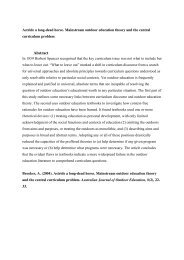
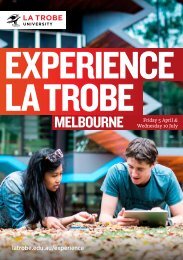
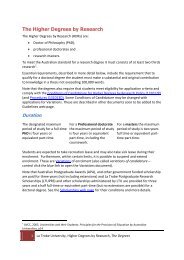
![Ottoman Empire course brochure [PDF 612KB] - La Trobe University](https://img.yumpu.com/12001562/1/184x260/ottoman-empire-course-brochure-pdf-612kb-la-trobe-university.jpg?quality=85)
![Getting Ready to Talk Manual [PDF 315KB] - La Trobe University](https://img.yumpu.com/11430807/1/190x245/getting-ready-to-talk-manual-pdf-315kb-la-trobe-university.jpg?quality=85)
